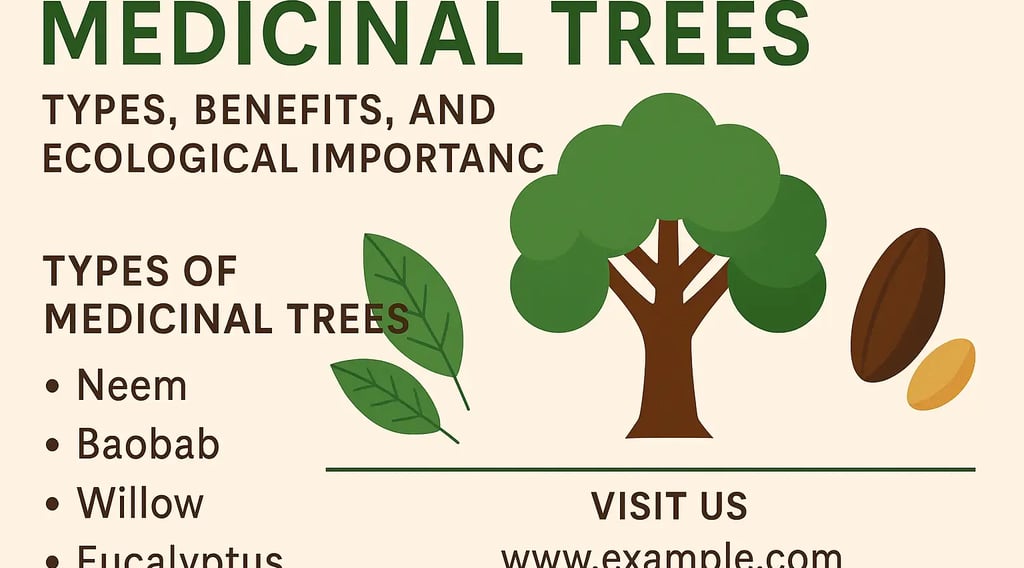Medicinal Trees: Types, Benefits, and Ecological Importance
Discover the top medicinal trees like Neem, Baobab, Willow, Eucalyptus, and African Blackwood. Learn their health benefits, ecological roles, and why conserving these natural healers is essential for our future.


Medicinal Trees: Types, Benefits, and Ecological Importance
Medicinal trees have been an integral part of human health and wellness for thousands of years. From ancient Ayurvedic treatments to modern pharmaceutical discoveries, these trees have provided natural remedies for countless ailments. Across cultures and continents, their bark, leaves, roots, and fruits have been harnessed for their healing properties, making them a bridge between nature and medicine.
In today’s world, where biodiversity is declining, the importance of preserving medicinal trees has never been greater. They not only hold the secrets to future drug discoveries but also play a vital role in maintaining ecological balance. This article explores the benefits, ecological significance, and popular types of medicinal trees, along with why conservation efforts are essential.
Why Medicinal Trees Matter
The use of medicinal trees dates back to ancient civilizations, with evidence found in Ayurvedic texts, Chinese medicine records, and Egyptian manuscripts. For example:
Neem (Azadirachta indica) is celebrated for its anti-inflammatory, antifungal, and antibacterial properties.
Willow bark is the original source of salicylic acid, the key ingredient in aspirin.
These examples highlight how traditional plant-based remedies have evolved into life-saving modern medicines.
However, the survival of medicinal tree species is under threat due to deforestation, climate change, and overharvesting. Conserving them not only protects human health but also sustains wildlife and ecosystems.
Ecological Importance of Medicinal Trees
Medicinal trees are more than just natural pharmacies — they are essential for a healthy planet.
1. Biodiversity Support
They provide habitat, food, and nesting spaces for birds, insects, and mammals, creating a balanced ecosystem.
2. Soil and Water Protection
Their roots prevent soil erosion, improve soil fertility, and protect water quality by filtering runoff.
3. Climate Change Mitigation
Medicinal trees absorb carbon dioxide, helping reduce greenhouse gas levels.
4. Cultural and Economic Value
Many medicinal trees have spiritual significance and provide income through sustainable harvesting.
Top Medicinal Trees and Their Benefits
1. Neem (Azadirachta indica)
Medicinal Uses: Treats acne, eczema, psoriasis; promotes oral health; boosts immunity.
Key Properties: Anti-inflammatory, antibacterial, antifungal.
Environmental Benefits: Drought-tolerant and low-maintenance, making it ideal for arid regions.
2. Baobab (Adansonia digitata)
Medicinal Uses: Nutrient-rich fruit supports immune health, aids digestion, and fights inflammation.
Nutritional Profile: 6x more Vitamin C than oranges, high in antioxidants, calcium, magnesium, and potassium.
Cultural Role: Known as the "Tree of Life" in Africa for its survival and healing benefits.
3. Willow (Salix species)
Medicinal Uses: Natural pain relief, fever reduction, arthritis treatment.
Active Compound: Salicylic acid (precursor to aspirin).
Sustainability Note: Requires careful harvesting to prevent ecosystem imbalance.
4. Eucalyptus (Eucalyptus globulus)
Medicinal Uses: Treats respiratory issues, clears congestion, heals wounds.
Key Properties: Antiseptic, decongestant, expectorant.
Ecological Impact: Must be managed sustainably to prevent water depletion and biodiversity loss.
5. African Blackwood (Dalbergia melanoxylon)
Medicinal Uses: Bark extracts used for anti-inflammatory and pain-relieving remedies.
Cultural Importance: Valued for making high-quality musical instruments.
Conservation Status: Endangered due to overharvesting; requires urgent protection.
How to Protect Medicinal Trees
Support Reforestation Programs – Participate in or donate to initiatives that plant native medicinal trees.
Buy Sustainable Products – Choose herbal and wood-based products from certified sustainable sources.
Promote Awareness – Share information about medicinal tree benefits through social media or community events.
Advocate for Policies – Support laws that protect endangered medicinal tree species.
Conclusion
Medicinal trees are nature’s healers and environmental guardians. They treat illnesses, enrich biodiversity, prevent soil erosion, and help combat climate change. By preserving them, we safeguard not only our health but also the future of our planet.
Every action counts — whether it’s planting a tree, choosing sustainable herbal products, or raising awareness. Let us work together to ensure that these life-saving natural resources continue to thrive for generations to come.
